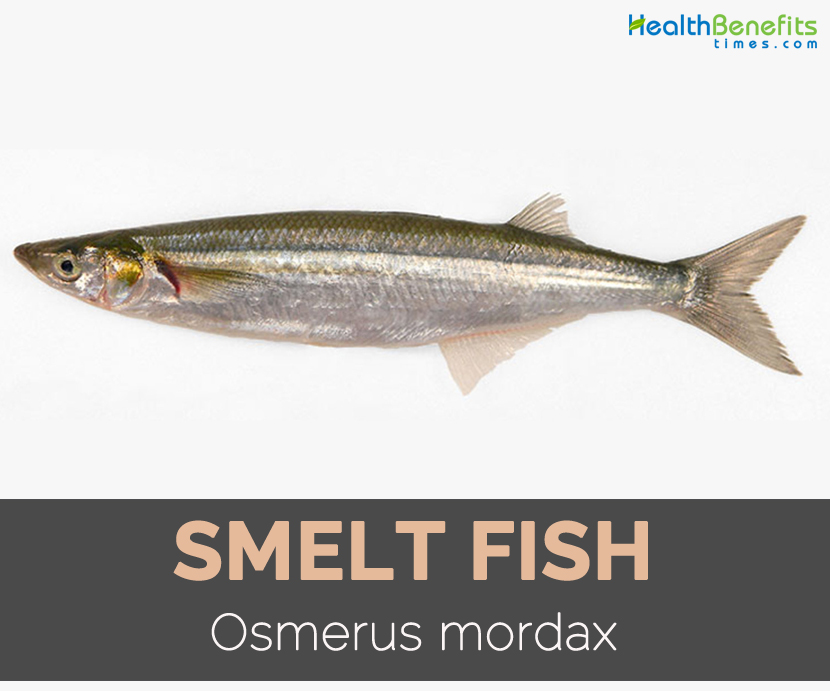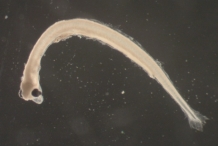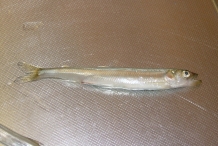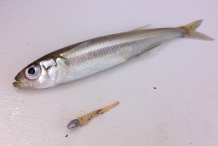These fish are found in Pacific and Atlantic Oceans. It is also called freshwater smelts or typical smelts in order to differentiate rom related Bathylagidae, Argentinidae and Retropinnidae. The smelt species are common in North American Great Lakes and seas or lakes of northern part of Europe where they move in large schools along saltwater coastline during spring migration to spawning streams. In recent decades, smelt populations have declined greatly in some western parts of United States leading to its protection under Endangered Species Act.
Description
Smelt has elongate and laterally compressed body. Head is moderate with moderately large eyes and pointed or elongated snout. Mouth is large with protruding lower jaw extending to middle of eye. Especially teeth are enlarged on tongue or front of vomer. The body is pale green with purple, pink and blue iridescent reflections on side when freshly caught. The long and slender body has large, elongated and pointed mouth. It has strong conical teeth on jaws and tongue with low than 75 scales along lateral line. It has adipose fin.
Diet
Rainbow smelt feeds on copepods, crustaceans, eggs, squids, fishes, worms and insects.
Health Benefits of Smelt fish
Let us discuss on the health benefits of Smelt fish:
- Skin health
B vitamins are essential for metabolic processes in the body for repair and growth of skin. Moreover, omega-3 fatty acids could lower inflammatory conditions on skin. Smelt fish is rich in selenium which is an antioxidant that improves skin appearance and lowers signs of aging.
- Improves hair
The regular consumption of Smelt fish offers essential vitamins and minerals required for the hair to look healthy and feel healthy. It has omega-3 fatty acids and natural oils which is essential for improving luster or shine of hair by suppressing inflammation on scalp conditions such as dandruff.
- Provides energy
Phosphorus is a mineral in the body and is a critical element to convert nutrients into usable energy. A single serving of smelt fish grants 20% of daily requirement of mineral. It delivers nutrients and energy in cells efficiently.
- Enhance nervous system
Calcium being electrolyte is a key part of signaling within nervous system. Smelt fish offers calcium that ensures muscle contractions and other messages within nervous system are effectively communicated.
- Heart ailments
Smelt fish has moderate amounts of potassium and it acts vasodilator that means it could lower tension in blood vessels and arteries. It lowers the chances of atherosclerosis, strokes, heart attacks and coronary heart disease.
- Balance cholesterol
All fats are not created equal and not all are bad for the body. Smelt fish has high content of omega-3 fatty acids that promotes cholesterol balance and heart health by lowering deposited plaque in arteries.
- Osteoporosis prevention
This fish provides various minerals such as phosphorus, manganese, copper, calcium, iron and zinc which are associated to bone mineral density in the body. The bone density starts to decline as we ages so consuming fish with high content of minerals helps to lower early onset of osteoporosis.
- Chronic ailments
It has large amounts of selenium found in smelt fish. Each serving offers 45% of daily requirement. This mineral acts as a powerful antioxidant. It lowers oxidative stress in the body and lowers the chances of chronic ailments such as heart disease, rheumatoid arthritis and cancer.
- Promotes development and growth
A serving of smelt fish provides 30% of daily requirement of protein. Amino acids in proteins could be reconstituted for production of muscle tissue and promote metabolism and supports weight loss efforts.
https://www.youtube.com/watch?v=n4z-9Ix4pz4
How to Eat
- It is consumed sautéed or fried.
- Pan-frying in butter and flour or deep frying in batter are the typical ways to prepare smelt fish.
- Smelt roe is used in sushi.
- Fried ones are added to curries.
- Roll it in breadcrumbs and deep fry.
- Preserve it by sun drying or steaming.
Other Facts
During April spawning run, smelt swarm in millions.
References:
https://www.itis.gov/servlet/SingleRpt/SingleRpt?search_topic=TSN&search_value=162041#null
https://en.wikipedia.org/wiki/Smelt_(fish)
https://www.thespruceeats.com/smelt-finger-food-extraordinaire-1300666
https://www.maine.gov/ifw/fish-wildlife/fisheries/species-information/rainbow-smelt.html
https://www.organicfacts.net/smelt-fish.html
Comments
| Smelt Fish Quick Facts | |
|---|---|
| Name: | Smelt Fish |
| Scientific Name: | Osmerus mordax |
| Origin | Extends through Atlantic drainages between New Jersey and Labrador to Arctic drainages, and the Pacific drainages as far south as Vancouver Island. |
| Colors | Pale green with purple, blue, and pink reflections |
| Shapes | Slender and cylindrical; 7 and 9 inches (18 and 23 cm) long |
| Flesh colors | White, lean |
| Calories | 105 Kcal./cup |
| Major nutrients | Vitamin B-12 (140.42%) Selenium (72.36%) Isoleucine (52.93%) Lysine (52.78%) Tryptophan (48.86%) |
| Health benefits | Skin health, Improves hair, Provides energy, Enhance nervous system, Heart ailments |
| Name | Smelt Fish |
|---|---|
| Scientific Name | Osmerus mordax |
| Native | Extends through Atlantic drainages between New Jersey and Labrador to Arctic drainages, and the Pacific drainages as far south as Vancouver Island. |
| Common/English Name | American smelt, Atlantic rainbow smelt, Bay capelin, Bay caplin, Freshwater smelt, Frost fish, Leefish, Ooutside caplin, Outside capelin, Rainbow smelt, Toothed smelt, White-fish, Typical smelts, European Smelt, Cucumber Smelt |
| Name in Other Languages | Chinese: Cǎihóng húguā yú (彩虹胡瓜鱼), Húguā yú (胡瓜鱼); Danish: Amerikansk smelt; Finnish: Amerikankuore; French: Èperlan arc-en-ciel, Éperlan d’Amérique; German: Amerikanischer Stint, Regenbogenstint; Inuktitut: Ichloanik, Ilhuagnik, Iquar-niq, Ithoanin, Qiqotiliqaoraq; Polish: Stynka amerykanska; Russian: Корюшка зубастая; Spanish: Eperlano Americano, Eperlano arco iris; Italian: Sperlano; Japanese: Kyûrino |
| Body shape & size | Slender and cylindrical; 7 and 9 inches (18 and 23 cm) long |
| Weight | 3 ounces (85 g) |
| Body color | Pale green with purple, blue, and pink reflections |
| Flesh | White, lean |
| Flavor | Sweet |
| Taste | Mild |
| Major Nutritions | Vitamin B-12 (Cobalamine) 3.37 µg (140.42%) Selenium, Se 39.8 µg (72.36%) Isoleucine 0.885 g (52.93%) Lysine 1.765 g (52.78%) Tryptophan 0.215 g (48.86%) Threonine 0.842 g (47.84%) Valine 0.989 g (46.83%) Histidine 0.565 g (45.86%) Leucine 1.561 g (42.23%) Protein 19.21 g (38.42%) |
| Calories in 3 oz (85 g) | 105 Kcal. |









